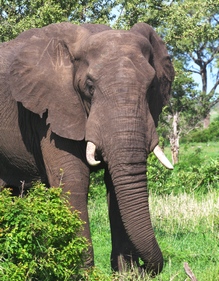
First published on The Conversation
African elephants are in serious danger. The magnificent creatures are found in 37 countries – and most of these populations are threatened by poaching. The problem is that protecting elephants isn’t cheap and conservationists struggle to fund their work.
In Africa, budgets are tight and governments have bigger priorities such as funding health and education. At an international level public sympathy for elephants rarely translates into cash, so donor funding is normally short-term and unpredictable.
This is why many African governments stockpiled ivory that was confiscated from poachers or came from elephants that died of natural causes before selling their ivory legally and using the money to pay for conservation work. This last happened in 2008 but several African countries are stockpiling more of their ivory for the future. Many countries outside Africa – prominent among them China – have markets for antique and legally stockpiled ivory.
So the sale of ivory can provide a reliable source of funding for elephant conservation. But outside Africa this trade is often passionately opposed. This partly comes from lack of awareness – many people think all ivory comes from poaching, whereas some comes from elephant deaths and herd conservation and management. Many people are also uneasy about the idea of making money from wildlife and are particularly uncomfortable when it involves animals as majestic as elephants.
This is one reason why in the last year several countries have destroyed their ivory stockpiles in the hope it will discourage trade and reduce poaching. In contrast, countries such as Botswana and South Africa, which have large and growing elephant populations, continue to store theirs.
Corruption in conservation
A more specific issue has come to light, however. We now have good evidence that the trade is being undermined by corruption. Poached ivory is being laundered as legal ivory and park staff, customs officials and politicians have been implicated. Some conservationists argue this corruption can’t be tackled and have called for a complete trade ban.
The fact that people are exposing these examples of corruption is a great step forward. This is because conservationists are generally wary of publicising the problem. However, together with colleagues, I recently argued that we should not single out the ivory trade. Corruption could be undermining every aspect of elephant conservation and we have no evidence that this trade is more affected.
Successful elephant conservation is based on funding park management, enforcing laws and sharing benefits with local people. All of these can be undermined by bribery, cronyism and embezzlement.
This is illustrated by a 2010 study that looked at how well African national parks protected their wildlife. It showed that all animals are in decline in the more corrupt countries, including lower-profile species such as antelopes and zebras. This suggests elephant numbers would be dropping anyway in these countries, independent of international wildlife trade policy.
Fortunately, evidence from business and anti-poverty projects does show that corruption can be tackled. An important first step is breaking up the problem into specific issues, such as embezzlement of national park budgets or bribery of police to turn a blind eye to poaching. This makes the task less daunting, changing the idea that corruption is a huge, unsolvable problem. Many of these problems can then be reduced by adopting good business practice. These include commonsense actions such as checking project bank accounts and sacking rule-breakers.
Another approach is to focus on where conservation groups have the most influence. Police and customs officials put most of their efforts into stopping crimes against people, not animals. So it makes sense for conservationists to try and stop elephants being poached in the first place.
Increasing success on the ground ensures healthy elephant populations and local people’s support for their conservation. It also tackles the problem of ivory laundering at source.
Tackling the problem
All of this suggests we can tackle corruption in elephant conservation but need to change how conservationists deal with the problem. A good start would be following the example of anti-poverty groups, such as CAFOD, Tearfund and Christian Aid. They recognised that corporate bribery was stopping them achieving their goals and took action. This is why they played an active role in publicising the problem and supporting new anti-corruption initiatives, such as the recent UK Bribery Act.
Just as importantly, the international community needs to consider corruption when developing elephant conservation strategies. At the moment, it takes a crisis before new policies and projects are developed. These initiatives then focus on countries with the biggest poaching problems and assume more money and stricter laws will help.
But such policies actually play into the hands of corrupt officials. It is much easier to steal money in a crisis and stricter laws just create more opportunities for bribery. Burning ivory reduces the supply and could increase prices on the black market. So unless corruption is tackled, investing in elephant poaching hot-spots will be a short-term solution at best.
Instead, we need projects to understand and tackle corruption. We should learn from countries with successful elephant conservation policies and give them a greater voice in international debates. Finally, we should discuss corruption more openly and use our head as well as our heart when trying to save Africa’s elephants.

